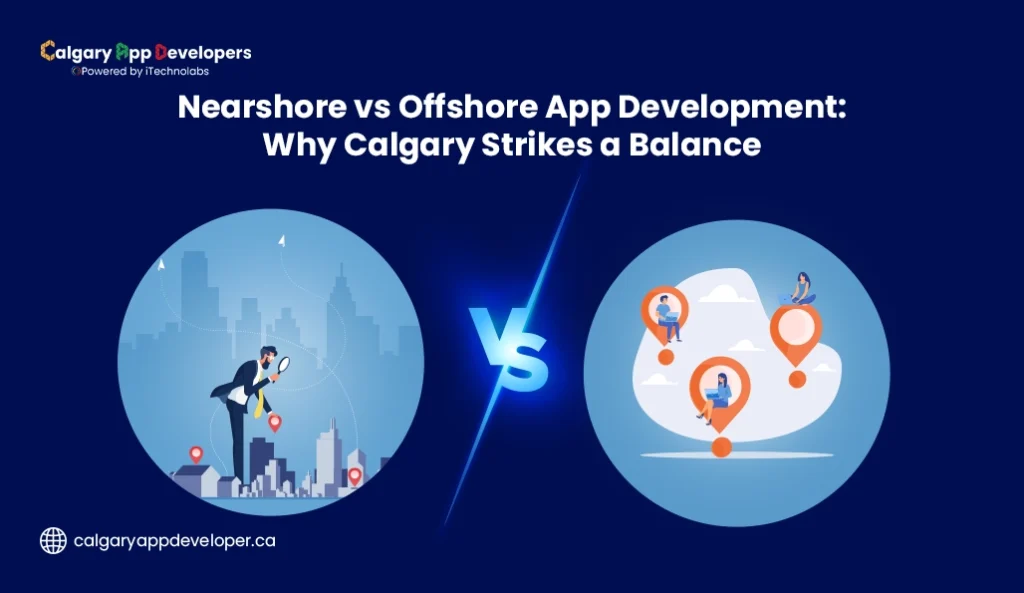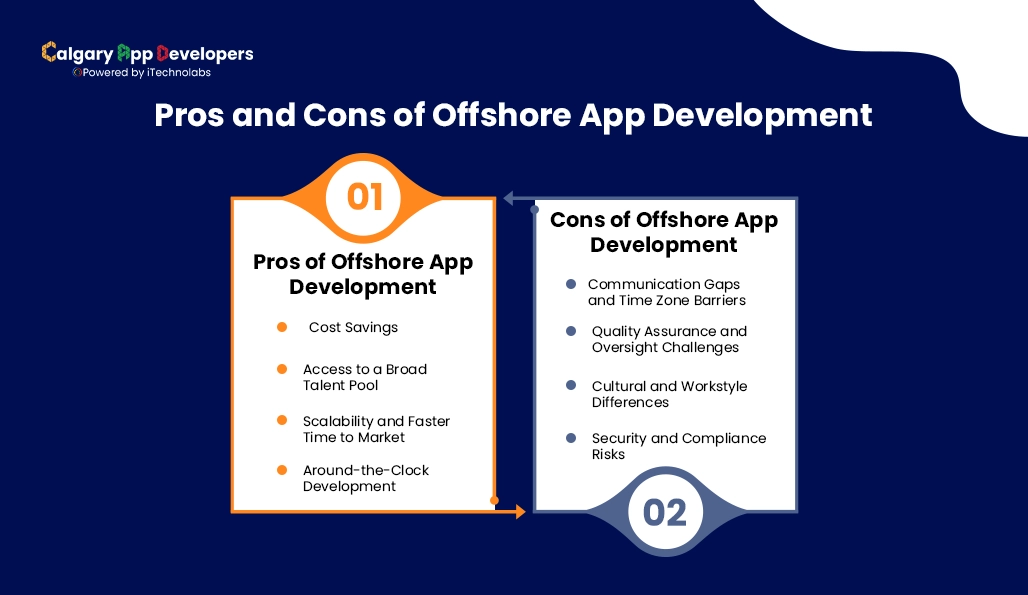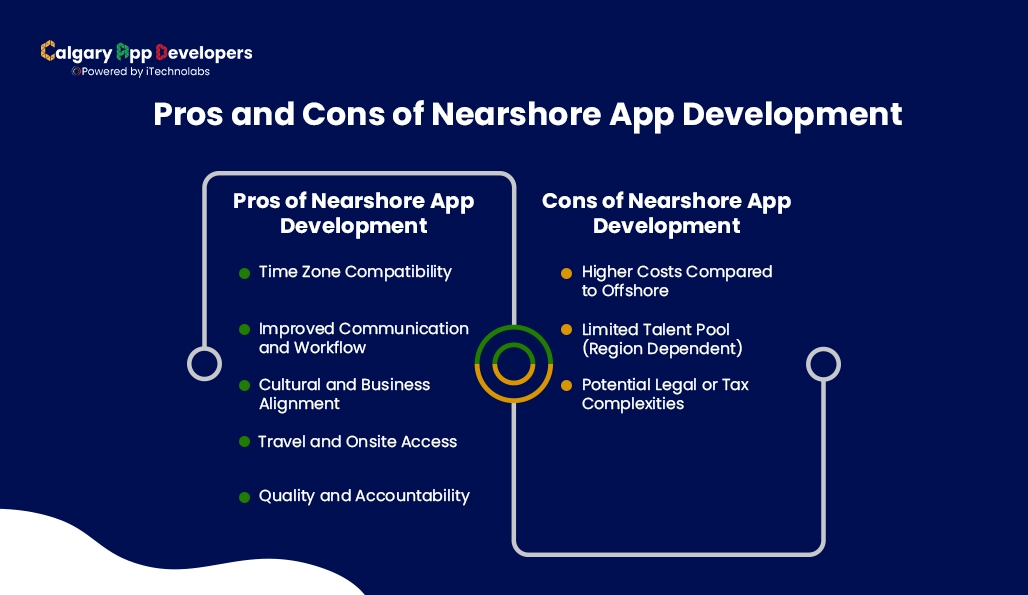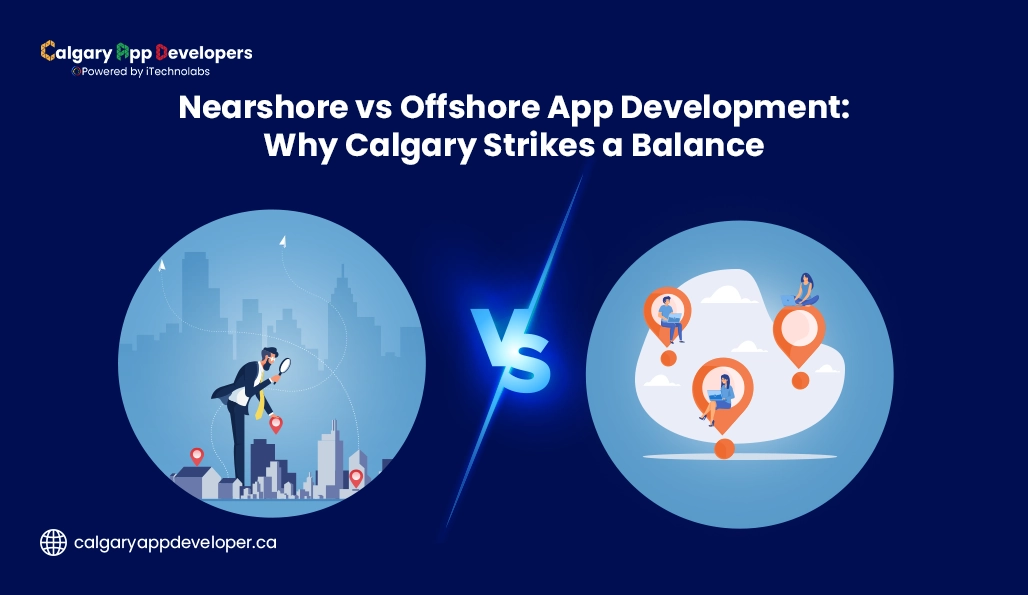Nearshore vs Offshore App Development: Why Calgary Strikes a Balance

When companies go to create an app, one of the first major choices isn’t necessarily about design or functionality—it’s where you go to build it. Offshore development might seem like a good way to save money, and nearshore alternatives promise improved communication and synchronization with time zones. But what if you could enjoy the best of both?
Calgary is quickly evolving into a strategic sweet spot—boasting world-class tech talent, affordable services, and strong cultural alignment to North American business. Picking an app developer Calgary helps you achieve balance between quality and affordability and facilitates better collaboration and faster turnarounds.
In this blog, we’ll explore how nearshore and offshore development compare—and why Calgary stands out as a balanced and forward-thinking choice for modern app development.
- Understanding Nearshore and Offshore Development
- Pros and Cons of Offshore App Development
- Pros and Cons of Nearshore App Development
- Comparison: Nearshore vs Offshore Development
- Why Calgary Is the Perfect Middle Ground
- Client Testimonials and Industry Recognition: Insights from Clutch and GoodFirms
- Choosing the Right Development Model for Your Business
- Conclusion:
Understanding Nearshore and Offshore Development
In selecting a development partner, learning the subtleties of differences between nearshore and offshore models can assist companies in making wiser, more budget-friendly choices. Both have their own strengths and weaknesses, particularly in terms of communication, time zones, and project synchronizations.
What Is Nearshore App Development?
Nearshore development is outsourcing your app project to a nearby country–typically a country in the same time zone with similar business practices. For North American companies, typically that means working with teams in Canada, Mexico, or a Latin American country.
The biggest benefit? Smooth communication. Teams are connected in real-time with minimal delay and maximum cultural alignment, so it’s much easier to maintain quality and forward momentum in the development process.
What Is Offshore App Development?
Offshore development is simply hiring external labor in distant countries, often on different continents (e.g., India, the Philippines, or Eastern Europe). The main benefit is the low cost (offshore team members are typically less expensive on an hourly basis).
However, offshore work generally suffers from a lack of communication, lengthy feedback loops from the time zone difference, and, at times, misaligned expectations or work culture.
Key Differences in Time Zone, Culture, and Collaboration
| Feature | Nearshore Development | Offshore Development |
| Time Zone | Aligned or similar | Significant differences |
| Communication | Real-time, easier collaboration | Often asynchronous, slower feedback |
| Cultural Fit | High cultural compatibility | May face cultural or language gaps |
| Project Control | More oversight and adaptability | May require more structured planning |
| Cost | Moderate | Typically lower |
For businesses looking for an effective compromise among quality, communication, and cost, areas such as mobile app development Calgary provide an attractive solution. With an expanding pool of talent and established connections to both Canadian and U.S. markets, Calgary leverages the advantages of nearshore proximity while providing international-caliber expertise.
Pros and Cons of Offshore App Development

Offshore app development means giving your software or app project over to a group in a faraway country, usually on different continents. It’s a strategy adopted by startups and big companies alike—who want to save money or ramp up development fast. Offshore development is not for every company, though. The following is the upside and downside of offshore app development in detail.
Pros of Offshore App Development
- Cost Savings
In general, offshore development tends to be far cheaper than using local talent. A U.S. or Canadian developer can cost between $100 and $150/hour depending on experience; the same level of expertise may be able to be hired for $25–50/hour in India or Vietnam. For long-running or larger projects, this variance in price could lead to significant savings over the lifetime of the project.
- Access to a Broad Talent Pool
Most offshore companies have large, talented staffs that can be scaled up or down quickly according to your project requirements. This means that businesses can ramp up development and get products to market faster and/or can work on different parts of a complex app concurrently.
- Scalability and Faster Time to Market
Most offshore companies have large, talented staffs that can be scaled up or down quickly according to your project requirements. This means that businesses can rapidly ramp up development and get products to market faster and/or can work on different parts of a complex app concurrently.
- Around-the-Clock Development
Offshore teams can work while your in-house teams are offline because of time-deferred functionality, making it possible to have almost continuous development. This approach usually works best for projects with short timelines because it enables progress to be made 24/7.
Cons of Offshore App Development
- Communication Gaps and Time Zone Barriers
Organizing a meeting or addressing urgent matters with teams that have an 8-12 hour time zone difference can be difficult. Consider a product manager in New York trying to get an answer to an urgent question from a team in India. That person may wait an entire day to get a response and until then, the product manager is unable to make a decision, which delays the process.
- Quality Assurance and Oversight Challenges
Given the physical distance and potential lack of transparency at times, quality assurance can be a challenge. If an offshore partner does not follow strong documentation and coding standards, this can lead to technical debt and bugs, which may not be easily distinguishable until later when trying to address the problem, and that can be expensive.
- Cultural and Workstyle Differences
Variations in communication style, the work environment or project goals may at times lead to misaligned expectations. For example, in some cultures, the developers may not always feel empowered to question vague or ambiguous requirements, and therefore a project may be delivered with the wrong implementation.
- Security and Compliance Risks
Depending on the nation and the infrastructure of the vendor, intellectual property protection and data security might be more difficult to implement. Regulated industries (such as healthcare or fintech) might struggle with compliance requirements when engaging offshore vendors.
Offshore application development is a strong means of reducing costs and speeding up development, particularly for well-defined projects that have little dependency on real-time communication. Yet it also takes more planning, proper documentation, and good vendor screening to guarantee quality and responsibility.
Pros and Cons of Nearshore App Development

Nearshore app development is the outsourcing of software projects to countries that are close by or neighboring to the contractor’s location – for example, U.S. companies using teams in Canada or Mexico. Nearshore development provides a happy medium of cost, communication, and collaboration, which has made it a viable alternative to offshore development and an attractive form of outsourcing.
Pros of Nearshore App Development
- Time Zone Compatibility
One of the greatest benefits of nearshoring is working in real-time collaboration. U.S. and Canadian teams, for instance, are usually 1–3 hours apart, which keeps meetings, feedback sessions, and troubleshooting sessions much more effective.
- Improved Communication and Workflow
Less time zone variation means less communication lag. This makes project management flow easier, speeds up decision-making, and requires fewer late-night or early-morning coordination calls.
- Cultural and Business Alignment
Nearshore teams frequently also share similar business values, legal frameworks, and work ethics. For example, by working with a Canadian or Latin American team, you will be able to leverage the more common North American business practices and minimize the risk of miscommunication or differing expectations.
- Travel and Onsite Access
Face-to-face meetings are easier with nearshore partners. If in-person work is a requirement—e.g., for workshops, training, or sprint planning—travel within the same continent is easier and less expensive to arrange.
- Quality and Accountability
The regulatory and coding standards, as well as quality assurance and compliance standards, tend to be more harmonious when working with nearshore partners. This is particularly true for the financial and healthcare sectors.
Cons of Nearshore App Development
- Higher Costs Compared to Offshore
Although still cheaper than hiring in-house, nearshore development is generally more costly than outsourcing offshore. For instance, onboarding a team in Mexico or Canada can be 20–30% higher than one based in India or Southeast Asia.
- Limited Talent Pool (Region Dependent)
Although talent access is still robust, nearshore locations have potentially fewer specialized developers in specialized technologies such as advanced AI, ML, or NLP compared to worldwide offshore markets.
- Potential Legal or Tax Complexities
Even with geographic proximity, legal and tax frameworks can differ across borders. Businesses need to carefully review contracts, IP protections, and data regulations to avoid complications.
Nearshore app development is an equilibrated mix of closeness, communication, and quality. It’s perfect for businesses that appreciate responsiveness, cultural affinity, and personal involvement in their project cycle. Take the case of collaboration with a Calgary app developer, for instance. This exposes U.S.-based businesses to readily available, high-quality development services at their doorstep without the logistical challenges of working with a team halfway across the world.
Also Read: Top Reasons to Hire a Calgary App Developer for Your Next Project
Comparison: Nearshore vs Offshore Development
| Feature | Nearshore Development | Offshore Development |
| Talent Accessibility | Moderate to high — skilled developers available but may be region-limited | Very high — access to a broad global talent pool |
| Travel Feasibility | Convenient — shorter flights and easier in-person visits | Less practical — long-distance travel is costly and time-consuming |
| Legal & IP Compliance | Easier to manage under familiar legal systems (e.g., USMCA, GDPR) | Riskier — must navigate foreign IP laws and enforcement limitations |
| Development Speed | Faster iteration due to better alignment and communication | Potential delays due to time zones and language barriers |
| Security Standards | Higher — more likely to follow similar cybersecurity frameworks | Varies — depends on local compliance and enforcement |
| Integration with Teams | Easier to embed with in-house teams; better team chemistry | Harder to integrate; may feel siloed due to distance and delays |
| Best For | Agile projects, quick pivots, and real-time collaboration | Budget-driven, well-defined, long-term projects |
Why Calgary Is the Perfect Middle Ground

When considering the advantages and disadvantages of developing an app nearshore versus offshore, Calgary stands out as a strong middle option—particularly for U.S.-based companies seeking high-caliber, cost-effective, and cooperative tech partners. Here’s why:
1. Geographic Proximity to the U.S.
Calgary offers a geographical advantage in Western Canada, close to American tech hubs including Seattle, San Francisco, Los Angeles, and Denver. The proximity allows for easier and less expensive travel for face-to-face meetings, onboarding sessions, or stakeholder workshops. Calgary-based teams are only a few hours away by plane, compared to offshore teams located 20+ hours away, with complicated visa processes. This travel accessibility ensures that hybrid collaboration models occur in a cost-effective and convenient way. It also helps foster trust and relationships— both key factors for any long-term development partnerships.
2. Time Zone Alignment and Real-Time Collaboration
Based in the Mountain Time Zone (MT), Calgary is well suited for real-time cooperation with North American clients. From Eastern Time or Pacific Time, Calgary teams can easily overlap 4–8 hours of your day, facilitating daily stand-ups, live feedback meetings, and real-time issue resolution.
This time zone synchronicity facilitates the adoption of agile methods efficiently—something that does not happen with offshore teams, where time lost due to a 10-12 hour time difference tends to delay iteration cycles and decision-making. For companies undertaking high-speed app projects, this can translate into a big difference in speed to market.
3. English Fluency and Cultural Compatibility
Often communication issues are the undoing of offshore projects, especially when there are language barriers and differences in the working culture. Calgary, as a major Canadian city, has full English fluency and a business culture that is nearly indistinguishable from that of the U.S.
This will allow for smoother onboarding onto the project, clearer documentation, and a more transparent discussion about the goals, deadlines, and expectations. The team will naturally understand Western project management styles, work ethics and collaboration tools, bringing integration with U.S. clients to a very manageable level. With a Calgary app developer, you are truly collaborating with a team that understands your business language, literally and from a professional standpoint.
Client Testimonials and Industry Recognition: Insights from Clutch and GoodFirms
Our research into Calgary-based app development firms, through trusted review platforms like Clutch and GoodFirms, reveals a consistent pattern of client satisfaction and industry credibility. Below is a synthesized overview of the key strengths and recurring themes expressed by clients across multiple projects:
Consistent Strengths Highlighted by Clients
- Strong Project Management and Communication
Across dozens of client reviews, project management stands out as a major positive. Clients frequently praise the clear and consistent communication channels maintained throughout the development lifecycle. This transparency enables real-time issue resolution, timely updates, and smoother coordination—especially critical for agile projects requiring frequent iterations.
“Their ability to maintain transparent communication and manage the project timelines effectively was repeatedly appreciated.”
- Quality and Attention to Detail
Quality assurance and attention to detail emerge as hallmarks of Calgary-based developers. Many clients note that deliverables not only meet but often exceed expectations, with a focus on user experience and functionality that aligns with business goals.
“The delivered product demonstrated exceptional polish and usability, reflecting deep attention to detail and a commitment to excellence.”
- Customized, Client-Centric Solutions
Clients consistently report receiving solutions tailored to their unique business needs, rather than off-the-shelf products. Calgary teams are recognized for taking the time to understand industry-specific requirements and adapting technologies accordingly.
“They invested effort into understanding our niche requirements, which translated into a highly customized and effective solution.”
- Post-Launch Support and Reliability
Another common theme is the dedication to ongoing support and maintenance after app launch. Clients emphasize the value of prompt updates, bug fixes, and iterative enhancements, which help ensure long-term app success.
“Support after launch was reliable and proactive, making it easier to maintain the app’s performance.”
- Expertise in Cross-Platform Development
Given the diverse device ecosystem in North America, cross-platform compatibility is crucial. Clients acknowledge the technical proficiency Calgary developers exhibit in building apps that function smoothly across multiple platforms without compromising performance.
“Their cross-platform development capabilities allowed us to expand our reach efficiently.”
Industry Recognition and Ratings Overview
- Clutch Ratings: Calgary-based firms generally score between 4.5 to 5 stars, reflecting strong client satisfaction.
- GoodFirms Feedback: Similar high ratings corroborate the reputation for professionalism, technical skills, and client service excellence.
- Common Client Sectors: Healthcare, fintech, retail, and logistics are prominent industries benefiting from Calgary’s app development expertise.
The aggregated client feedback and ratings from top review platforms position mobile app development Calgary as a trusted and reputable hub for app development services. The city’s agencies combine quality, communication, and customized solutions with dependable post-launch support—key factors that drive client loyalty and positive industry recognition.
Read Also: The Rise of Calgary App Makers: Innovation in Canada’s Tech Scene
Choosing the Right Development Model for Your Business

Selecting the most suitable app development model is a critical decision that influences your project’s success. Whether your business opts for onshore, nearshore, or offshore development, the right choice depends on your goals, budget, technical requirements, and need for collaboration.
Key Factors to Consider
1. Project Complexity and Collaboration Needs
Complex applications—such as those in healthcare, fintech, or logistics—require active collaboration, frequent feedback, and agile development cycles. In such cases, nearshore or onshore models are often more effective due to easier communication and aligned work hours.
By contrast, offshore development may suit well-defined, standalone projects that require minimal adjustments after the initial brief.
Example: A business developing a healthcare compliance app involving ongoing updates and user testing would benefit from a nearshore partner due to the need for continuous iteration.
2. Budget vs. Quality Trade-Off
- Offshore development is usually the most cost-effective option. However, it can involve challenges like time zone differences, limited oversight, or communication delays.
- Nearshore development provides a balance—offering competitive pricing while maintaining a closer working relationship.
- Onshore development typically involves the highest cost but provides full access, cultural alignment, and ease of collaboration.
A mid-sized company seeking a balance between affordability and collaboration might hire a Calgary app developer to combine quality output with cost control.
3. Time Zone Alignment and Communication
Time zone differences play a major role in development efficiency. Nearshore teams in Canada or Latin America provide overlapping work hours for North American companies, enabling real-time collaboration. Offshore teams, in contrast, may result in delayed responses and slower decision-making.
Efficient communication is especially vital during design sprints, user testing, and deployment phases.
4. Long-Term Support and Scaling
App development doesn’t end at launch. Ongoing maintenance, feature rollouts, bug fixes, and scaling require consistent support. Teams that understand your app’s architecture and product vision are better positioned for long-term success.
Nearshore and onshore teams often provide better continuity and adaptability for growing businesses compared to offshore teams that may only engage for project-specific scopes.
Conclusion:
In today’s competitive and connected world, selecting the right app development model—be it nearshore or offshore—can make a significant difference in your project’s outcome. While offshore development offers cost advantages, it often comes with communication and oversight challenges. Nearshore development, on the other hand, provides a balanced approach with better collaboration, time zone alignment, and cultural compatibility. Ultimately, the right choice depends on your unique business needs, goals, and the complexity of your application. Understanding the strengths and limitations of each model empowers businesses to make informed decisions that lead to efficient delivery, improved product quality, and long-term success. The right partner is one that aligns with your vision and adapts with your growth.

Pankaj Arora
Founder, Calgary App Developers
Pankaj Arora is a seasoned technology leader and the Founder of Calgary App Developers, with 7+ years of expertise in crafting high-performance digital solutions. His core competencies include full-stack app development, cloud-native architecture, API integration, and agile product delivery. Under his leadership, Calgary App Developers has empowered startups and enterprises alike with scalable mobile applications, secure web platforms, and AI-driven SaaS products.





